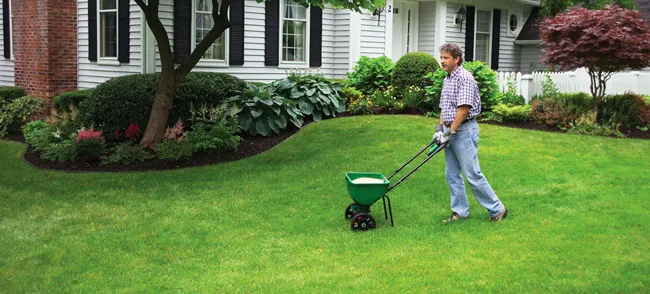Gainesville Lawn Fertilization in the fall is vital to keep your lawn healthy through the winter and the key to a vibrant Gainesville lawn free of pests and disease next Spring. Many people understand that fall is the best time to do it, but not many people understand why, or the best way to go about it. While there are distinct differences between the lawn treatment for pests and lawn fertilization, here are some tips to handle both this fall.
How can we get our lawns ready for winter?
In Gainesville lawns, the transition from summer growth to winter growth typically begins sometime between mid-September and mid-October. This transition comes earlier in northern parts of the country but is revealed by a distinctive decrease in the amount of upright growth, which decreases the need for frequent mowing.
This transitional period is an ideal time to provide Gainesville fertilization and lawn treatment to enhance the nutrients available as your yard prepares for winter. You should also perform core aeration and this is the perfect time for over-seeding with winter rye if that is your plan. Well fertilized grass will store up significant food reserves and produce healthy roots during the next 60 days to sustain it during the winter. Core aeration promotes significant root growth during the transitional period, which also prepares your lawn for a stronger spring and gives better Gainesville weed control as the turf is too thick to allow penetration.
How do we read a bag of fertilizer to know what to apply into our Gainesville lawn?
The three numbers on a fertilizer bag indicate the amount of primary nutrients by weight. The three primary nutrients are Nitrogen, Phosphorus and Potassium (N-P-K). For example, a 50 pound bag of 16-0-8 lawn fertilizer contains eight pounds of nitrogen, zero pounds of phosphorus and four pounds of potassium.
What should be looked for in a Gainesville lawn fertilzation?
Look for a fertilizer analysis (N-P-K) that has a 1-0-1 or 2-0-1 nutrient ratio. For example, a 16-0-16 or 20-0-20 is a 1-0-1 ratio fertilizer and 16-0-8 or 20-0-10 is a 2-0-1 ratio fertilizer.
A lawn fertilizer should not include phosphorus (the middle number) unless a soil test has indicated the need to supply additional phosphorus. In Florida, a fertilizer which also contains the micronutrients iron and manganese in addition to the primary nutrients is good as well.
How does my Gainesville yard benefit from these nutrients?
There are 16 essential elements necessary for nutrition of lawn turfgrass. Of those 16, three (Nitrogen, Phosphorus and Potassium) are most commonly used in fertilizers.Turfgrass requires nitrogen in the largest amount of any essential nutrient with the exception of carbon, hydrogen and oxygen. For this reason, nitrogen is applied in the largest amount in fertilization programs. It greatly influences shoot and root growth, color and recuperative potential. If you want more growth and greener color, you will get significant improvement by adding more nitrogen. Phosphorus is involved in a number of physiological functions within the grass plant. It affects the initial establishment, rooting and reproduction of turfgrass. Most soils are found to contain adequate amounts of available phosphorus, so adding this to a fertilizer blend is usually unnecessary. Potassium is essential for plant growth and development. It greatly influences rooting, disease proneness and drought stress tolerance. Most soils are low in available potassium so it is very important to include this in your fertilizer.
Is fall a good time for Gainesville weed control?
The best method to control weeds is a dense, healthy lawn. Proper fertilization, mowing and watering are the foundation for a healthy lawn. The fall application of a pre-emergent Gainesville weed control products will greatly reduce the number of weeds that develop during the fall and winter months. If weeds do develop in areas, applying a selective herbicide can be used to get them out of your lawn by a local Gainesville lawn care professional.
If the lawn is dense and healthy, and if a pre-emergent product is used, you will likely have very few weeds to contend with during the winter months. If weeds become a significant problem for you, then seek a professional's advice on the best method for dealing with the problem.
What should I do about Gainesville lawn pest control?
Most lawn insect problems occur during the summer months. Some of the pests you might see during the fall are Chinch bugs, web worms, or army worms. All pest problems should first be accurately identified by a Gainesville Florida lawn care professional, and then treated with a material that is specifically labeled for control of that pest. Many of these products are applied through a hose end applicator or granular spreader. Indiscriminate application of a pesticide is an unnecessary and irresponsible approach to dealing with lawn pests.
What kind of lawn care is needed in winter months?
Lawns should be continued to be mowed during the fall and winter months in the Alauchua County area but will require it on a less frequent basis. A rule of thumb is to mow the lawn every other week during this period. Water the lawn less frequently as well. Most southern lawns should have Gainesville irrigation run with three quarters of an inch of water every seven to ten days during this period.
Anything else we should know about fall lawn care?
Fall and winter is when lawns recuperate. Properly maintaining them during the fall and winter will make them much more capable of dealing with summer stresses next year. Remember that, regardless of your grass type, fall and winter is an excellent time to improve the overall health and vigor of your lawn.
If any of these details of how to take care of your lawn overwhelm you, please call our office at 378-5296 and we are always able to help.


